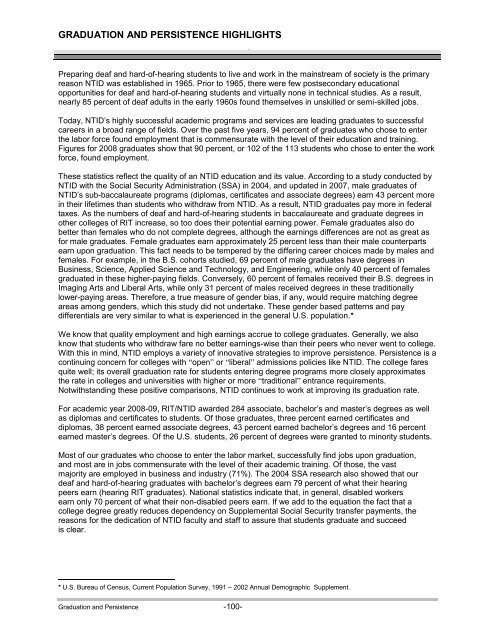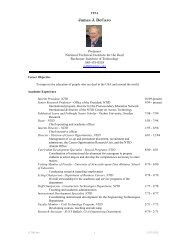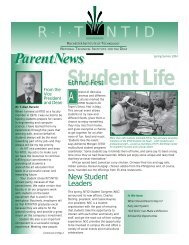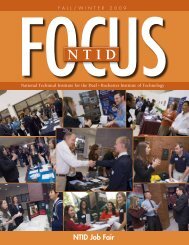Social Security Disability Insurance (SSDI) - National Technical ...
Social Security Disability Insurance (SSDI) - National Technical ...
Social Security Disability Insurance (SSDI) - National Technical ...
You also want an ePaper? Increase the reach of your titles
YUMPU automatically turns print PDFs into web optimized ePapers that Google loves.
GRADUATION AND PERSISTENCE HIGHLIGHTS<br />
Preparing deaf and hard-of-hearing students to live and work in the mainstream of society is the primary<br />
reason NTID was established in 1965. Prior to 1965, there were few postsecondary educational<br />
opportunities for deaf and hard-of-hearing students and virtually none in technical studies. As a result,<br />
nearly 85 percent of deaf adults in the early 1960s found themselves in unskilled or semi-skilled jobs.<br />
Today, NTID’s highly successful academic programs and services are leading graduates to successful<br />
careers in a broad range of fields. Over the past five years, 94 percent of graduates who chose to enter<br />
the labor force found employment that is commensurate with the level of their education and training.<br />
Figures for 2008 graduates show that 90 percent, or 102 of the 113 students who chose to enter the work<br />
force, found employment.<br />
These statistics reflect the quality of an NTID education and its value. According to a study conducted by<br />
NTID with the <strong>Social</strong> <strong>Security</strong> Administration (SSA) in 2004, and updated in 2007, male graduates of<br />
NTID’s sub-baccalaureate programs (diplomas, certificates and associate degrees) earn 43 percent more<br />
in their lifetimes than students who withdraw from NTID. As a result, NTID graduates pay more in federal<br />
taxes. As the numbers of deaf and hard-of-hearing students in baccalaureate and graduate degrees in<br />
other colleges of RIT increase, so too does their potential earning power. Female graduates also do<br />
better than females who do not complete degrees, although the earnings differences are not as great as<br />
for male graduates. Female graduates earn approximately 25 percent less than their male counterparts<br />
earn upon graduation. This fact needs to be tempered by the differing career choices made by males and<br />
females. For example, in the B.S. cohorts studied, 69 percent of male graduates have degrees in<br />
Business, Science, Applied Science and Technology, and Engineering, while only 40 percent of females<br />
graduated in these higher-paying fields. Conversely, 60 percent of females received their B.S. degrees in<br />
Imaging Arts and Liberal Arts, while only 31 percent of males received degrees in these traditionally<br />
lower-paying areas. Therefore, a true measure of gender bias, if any, would require matching degree<br />
areas among genders, which this study did not undertake. These gender based patterns and pay<br />
differentials are very similar to what is experienced in the general U.S. population.*<br />
We know that quality employment and high earnings accrue to college graduates. Generally, we also<br />
know that students who withdraw fare no better earnings-wise than their peers who never went to college.<br />
With this in mind, NTID employs a variety of innovative strategies to improve persistence. Persistence is a<br />
continuing concern for colleges with “open” or “liberal” admissions policies like NTID. The college fares<br />
quite well; its overall graduation rate for students entering degree programs more closely approximates<br />
the rate in colleges and universities with higher or more “traditional” entrance requirements.<br />
Notwithstanding these positive comparisons, NTID continues to work at improving its graduation rate.<br />
For academic year 2008-09, RIT/NTID awarded 284 associate, bachelor’s and master’s degrees as well<br />
as diplomas and certificates to students. Of those graduates, three percent earned certificates and<br />
diplomas, 38 percent earned associate degrees, 43 percent earned bachelor’s degrees and 16 percent<br />
earned master’s degrees. Of the U.S. students, 26 percent of degrees were granted to minority students.<br />
Most of our graduates who choose to enter the labor market, successfully find jobs upon graduation,<br />
and most are in jobs commensurate with the level of their academic training. Of those, the vast<br />
majority are employed in business and industry (71%). The 2004 SSA research also showed that our<br />
deaf and hard-of-hearing graduates with bachelor’s degrees earn 79 percent of what their hearing<br />
peers earn (hearing RIT graduates). <strong>National</strong> statistics indicate that, in general, disabled workers<br />
earn only 70 percent of what their non-disabled peers earn. If we add to the equation the fact that a<br />
college degree greatly reduces dependency on Supplemental <strong>Social</strong> <strong>Security</strong> transfer payments, the<br />
reasons for the dedication of NTID faculty and staff to assure that students graduate and succeed<br />
is clear.<br />
* U.S. Bureau of Census, Current Population Survey, 1991 – 2002 Annual Demographic Supplement.<br />
Graduation and Persistence -100-








